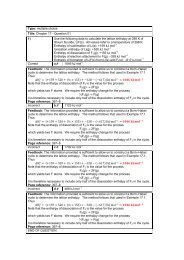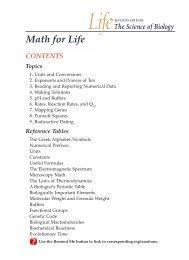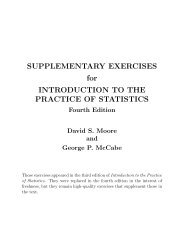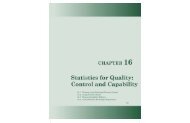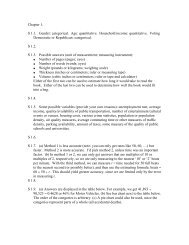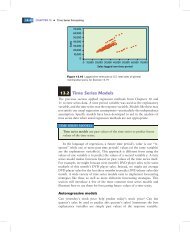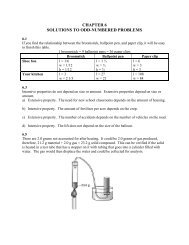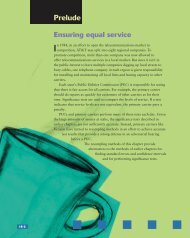Life: The Science of Biology, 10e - WH Freeman
Life: The Science of Biology, 10e - WH Freeman
Life: The Science of Biology, 10e - WH Freeman
Create successful ePaper yourself
Turn your PDF publications into a flip-book with our unique Google optimized e-Paper software.
Lecture Notebookto accompanySinauer Associates, Inc.MacMillanCopyright © 2014 Sinauer Associates, Inc. Cover photograph © Alex Mustard/naturepl.com.This document may not be modified or distributed (either electronically or on paper) without the permission <strong>of</strong> the publisher, withthe following exception: Individual users may enter their own notes into this document and may print it for their own personal use.
Chapter 54 | Ecology and the Distribution <strong>of</strong> <strong>Life</strong> 3EquinoxSeptember 22Earth’s orbitWhen the SouthernHemisphere is tiltedtoward the sun, it issummer there andwinter in the NorthernHemisphere.23.5°When the NorthernHemisphere is tiltedtoward the sun, it issummer there andwinter in the SouthernHemisphere.SolsticeDecember 21North PoleSolsticeJune 21EquinoxMarch 2054.2 Seasonal Change Is the Result <strong>of</strong> the Tilt <strong>of</strong> Earth’s Axis (Page 1123)LIFE <strong>The</strong> <strong>Science</strong> <strong>of</strong> <strong>Biology</strong> 10E SadavaSinauer AssociatesMorales StudioFigure 54.02 Date 07-13-12© 2014 Sinauer Associates, Inc.
Chapter 54 | Ecology and the Distribution <strong>of</strong> <strong>Life</strong> 4Dry90°(A)Descending airRising air(B)Wet60°1In the tropics, warm, moistair rises, expands andcools, drops its moisture,and flows poleward.30°NDry30°Sunlight0°Wet0°30°SDry30°2<strong>The</strong> now cool, dry air warms andretains its moisture as it descends.It reaches Earth’s surface at about30°N and 30°S.WetDry60°90°54.3 Air Circulation in Earth’s Atmosphere (Page 1124)LIFE <strong>The</strong> <strong>Science</strong> <strong>of</strong> <strong>Biology</strong> 10E SadavaSinauer AssociatesMorales StudioFigure 54.03 Date 07-13-12© 2014 Sinauer Associates, Inc.
Chapter 54 | Ecology and the Distribution <strong>of</strong> <strong>Life</strong> 5Atmosphericcirculation(see Figure 54.3)90°Easterlies60°Westerlies30°NE Trade WindsSE Trade Winds0°Direction<strong>of</strong> Earth’srotation30°WesterliesEasterlies60°90°54.4 Prevailing Winds (Page 1125)LIFE <strong>The</strong> 90° <strong>Science</strong> <strong>of</strong> <strong>Biology</strong> 9E SadavaSinauer AssociatesMorales StudioFigure 54.03 Date 07-13-0960°2 …where it moveswestward until itreaches a continent…1 <strong>The</strong> trade windspush water towardthe equator…LabradorCurrentNorthAtlanticDrift30°KuroshioCurrentN. Pacific DriftGulfStreamLatitude0°30°BenguelaCurrent60°3 …then moves north or southalong the coast, forming greatcircular currents called gyres.90°54.5 Oceanic Circulation (Page 1125)West Wind DriftWest Wind Drift4 <strong>The</strong> EquatorialCountercurrentarises between thehemispheric gyres.© 2014 Sinauer Associates, Inc.
Chapter 54 | Ecology and the Distribution <strong>of</strong> <strong>Life</strong> 6Rana sylvatica54.6 An Evolutionary Adaptation to Climate (Page 1126)<strong>Life</strong><strong>10e</strong>_54.06SInauer Associates04.04.12© 2014 Sinauer Associates, Inc.
Chapter 54 | Ecology and the Distribution <strong>of</strong> <strong>Life</strong> 730ºNEquator30ºSTropical rainforestTropical deciduous forestThorn forestTropical savannaHot desertChaparralCold desertHigh mountains(boreal forest and tundra)Temperate evergreen forestTemperatedeciduous forestBoreal forestArctic tundraTemperate grasslandPolar ice cap54.7 Global Distribution <strong>of</strong> the Major Terrestrial Biomes (Page 1127)LIFE <strong>The</strong> <strong>Science</strong> <strong>of</strong> <strong>Biology</strong> 10E SadavaSinauer AssociatesMorales StudioFigure 54.07 Date 07-13-12© 2014 Sinauer Associates, Inc.
Chapter 54 | Ecology and the Distribution <strong>of</strong> <strong>Life</strong> 82On the windward side <strong>of</strong> the mountain,air rises and cools, releasing moisturein the form <strong>of</strong> rain or snow and leadingto lush vegetation.1Prevailing windspick up moistureover water bodies.3 On the leeward side <strong>of</strong> themountain, air descends, warms, andpicks up moisture, which results inlittle rain and arid conditions.54.8 Rain Shadow (Page 1127)LIFE <strong>The</strong> <strong>Science</strong> <strong>of</strong> <strong>Biology</strong> 10E SadavaSinauer AssociatesMorales StudioFigure 54.08 Date 07-13-12© 2014 Sinauer Associates, Inc.
Chapter 54 | Ecology and the Distribution <strong>of</strong> <strong>Life</strong> 9TUNDRAArctic tundra isfound at highlatitudes.Alpine tundrais found at highelevations.EquatorAlpine tundra: Giant groundsel (Dendrosenecio keniensis) on theslopes <strong>of</strong> Mt. Kilimanjaro, TanzaniaArctic tundra: Caribou (Rangifer tarandus)in Denali National Park, AlaskaCommunity compositionDominant plantsPerennial herbs and small shrubsSpecies richnessPlants: Low; higher in tropical alpineAnimals: Low; many birds migrate in forsummer; a few species <strong>of</strong> insectsabundant in summerSoil biotaFew species20°C is a“comfortable”68°F.0°C is thefreezing point<strong>of</strong> water(=32°F).Temperature°CUpernavik, Greenland 73°N20151050–5–10–15–20–25JanWinter isvery coldand long.5 cm equalsjust over 2inches.Summer is cooland short.Range 28°CJulPrecipitationcm5 Annual total: 23 cm0JanJulDecDec<strong>The</strong> feathery feet and white plumage <strong>of</strong> thewillow ptarmigan (Lagopus lagopus) areadaptations to the snows <strong>of</strong> the Arctic tundrain Manitoba.(Page 1128)LIFE <strong>The</strong> <strong>Science</strong> <strong>of</strong> <strong>Biology</strong> 10E SadavaSinauer AssociatesMorales StudioFigure 54.Biome 1 Date 07-13-12© 2014 Sinauer Associates, Inc.
Chapter 54 | Ecology and the Distribution <strong>of</strong> <strong>Life</strong> 10BOREAL and TEMPERATE EVERGREEN FORESTTemperateevergreen forestsare found alongthe coasts.EquatorSouthern beech (Noth<strong>of</strong>agus) in the temperate evergreen forest<strong>of</strong> Fiordland National Park, New ZealandBull moose (Alces alces) in boreal forest,Alberta, CanadaCommunity compositionDominant plantsTrees, shrubs, and perennial herbsSpecies richnessPlants: Low in trees, higher in understoryAnimals: Low, but with summer peaks inmigratory birdsSoil biotaVery rich in deep litter layerTemperature°CWinter is15very cold10 and dry.50–5–10–15–20–25–30Jan50JanRange 41°CJulSummer is mildand humid.Ft. Vermillion, Alberta 58°NPrecipitationcmAnnual total: 31 cmJulDecDec<strong>The</strong> boreal owl (Aegolius funereus) feeds oninsects and small birds and mammals <strong>of</strong> theconiferous evergreen forests <strong>of</strong> Europe andNorth America. <strong>The</strong> owl lives in the forestsyear-round, dispersing occasionally whenfood becomes extremely scarce.(Page 1129)LIFE <strong>The</strong> <strong>Science</strong> <strong>of</strong> <strong>Biology</strong> 10E SadavaSinauer AssociatesMorales StudioFigure 54.Biome 2 Date 07-13-12© 2014 Sinauer Associates, Inc.
Chapter 54 | Ecology and the Distribution <strong>of</strong> <strong>Life</strong> 11TEMPERATE DECIDUOUS FORESTEquatorFallen oak leaves on the winter forest floor, New York StateTemperature Summer is warm°Cand moist.252015Winter iscold andsnowy.105Range 31°C0–5Madison, Wisconsin 43°N–10JanJulDecPrecipitationcm1050JanAnnual total: 81 cmJulDecMourning cloak butterflies (Nymphalis antiopa)overwinter as adults, settled in crevices andunder tree bark in the deciduous forests <strong>of</strong>eastern North America. <strong>The</strong>ir early appearanceis a harbinger <strong>of</strong> spring.Black bears (Ursus americanus) are commonin North American deciduous forests.Community compositionDominant plantsTrees and shrubsSpecies richnessPlants: Many tree species in southeasternU.S. and eastern Asia, rich shrub layerAnimals: Rich; many migrant birds,richest amphibian communities on Earth,rich summer insect faunaSoil biotaRich(Page 1130)LIFE <strong>The</strong> <strong>Science</strong> <strong>of</strong> <strong>Biology</strong> 10E SadavaSinauer AssociatesMorales StudioFigure 54.Biome 3 Date 07-13-12© 2014 Sinauer Associates, Inc.
Chapter 54 | Ecology and the Distribution <strong>of</strong> <strong>Life</strong> 13HOT DESERTHot deserts arefound at about30° north andsouth <strong>of</strong> theequator.EquatorSucculents such as agave, candelabra, and cardon characterize thedeserts <strong>of</strong> the North American Southwest.Gemsbok (Oryx gazella) on the dunes,Namib-Naukluft National Park, NamibiaCommunity compositionDominant plantsMany different growth forms (but few or no trees)Species richnessPlants: Moderately rich; many annualsAnimals: Very rich in rodents; richest beecommunities on Earth; very rich in reptilesand butterfliesSoil biotaFew species<strong>The</strong> fog-basking beetle (Onymacris unguicularis)retrieves the water it needs to survive from themorning fogs <strong>of</strong> Africa’s Namib Desert.Temperature°CRange 9.5°C403020 Winter isvery warm10and dry.0JanJulPrecipitationcmAnnual total: 15 cm50JanJulKhartoum,Sudan 15.5°NSummer is verywarm and less dry.DecDec(Page 1132)LIFE <strong>The</strong> <strong>Science</strong> <strong>of</strong> <strong>Biology</strong> 10E SadavaSinauer AssociatesMorales StudioFigure 54.Biome 5 Date 07-13-12© 2014 Sinauer Associates, Inc.
Chapter 54 | Ecology and the Distribution <strong>of</strong> <strong>Life</strong> 14COLD DESERTEquatorVicuña (Vicugna vicugna) family herd in Andean desert,Lauca National Park, ChileA cold desert in northern New Mexico, at about 2,000 meters in elevation, isdominated by juniper shrubs (Juniperus sp.).Community compositionDominant plantsLow-growing shrubs and herbaceousplantsSpecies richnessPlants: Few speciesAnimals: Rich in seed-eating birds, ants,and rodents; low in all other taxaSoil biotaPoor in species°C3025TemperatureWinter is cold andvery dry.Summer ismuch warmer,but still dry.2015105Range 23°C0–5Cheyenne, Wyoming 41°N–10JanJulDecPrecipitationcm50JanAnnual total: 38 cmJulLiving in a cold desert presents specialchallenges to a poikilotherm. This collaredlizard (Crotaphytus sp.) in Bluff, Utah, iswarming itself by basking on a rock.Dec(Page 1133)tttLIFE <strong>The</strong> <strong>Science</strong> <strong>of</strong> <strong>Biology</strong> 10E SadavaSinauer AssociatesMorales StudioFigure 54.Biome 6 Date 07-13-12© 2014 Sinauer Associates, Inc.
Chapter 54 | Ecology and the Distribution <strong>of</strong> <strong>Life</strong> 16THORN FOREST and TROPICAL SAVANNAEquatorMadagascar ocotillo (Alluadia procera)dominate this thorn forest.Community compositionDominant plantsShrubs and small trees; grassesSpecies richnessPlants: Moderate in thorn forest; low insavannaAnimals: Rich mammal faunas; moderatelyrich in birds, reptiles, and insectsSoil biotaRichDecAnnual total: 74 cmFamily groups <strong>of</strong> African elephants (Loxodonta africana) inKenya’s Ol Malo Wildlife Sanctuary converge into a largeherd for migration.TemperatureSummer is verywet, but not much°C Winter is mild and very dry. warmer than winter.353025 Kayes, Mali 14°N20Range 10.7 °CJanJulcmPrecipitation20151050JanJulDecTermite colonies build huge mounds on the Africansavanna, providing a food source for mammals suchas this baboon (Papio sp.).(Page 1135)LIFE <strong>The</strong> <strong>Science</strong> <strong>of</strong> <strong>Biology</strong> 10E SadavaSinauer AssociatesMorales StudioFigure 54.Biome 8 Date 07-13-12© 2014 Sinauer Associates, Inc.
Chapter 54 | Ecology and the Distribution <strong>of</strong> <strong>Life</strong> 17TROPICAL DECIDUOUS FORESTEquatorA forest canopy <strong>of</strong> pijio trees (Cavanillesia platanifolia) during the dryseason in Cerro Blanco on the Ecuadoran coastTemperatureBengal tiger (Panthera tigris tigris) in theforests <strong>of</strong> Bandhavgarh, India.Community compositionDominant plantsDeciduous treesSpecies richnessPlants: Moderately rich in tree speciesAnimals: Rich mammal, bird, reptile, andamphibian communities; rich in insectsSoil biotaRich, but poorly knownHummingbirds such as Amazilia tzacatl aremajor pollinators in this biome.°C302520Winter is veryhot and dry.Range 5.4°CSummer is hotand wet.JanJulPrecipitationcm35 Annual total: 163 cm302520151050JanJulTimbo,Guinea 10°NDecDec(Page 1136)LIFE <strong>The</strong> <strong>Science</strong> <strong>of</strong> <strong>Biology</strong> 10E SadavaSinauer AssociatesMorales StudioFigure 54.Biome 9 Date 07-13-12© 2014 Sinauer Associates, Inc.
Chapter 54 | Ecology and the Distribution <strong>of</strong> <strong>Life</strong> 18TROPICAL RAINFORESTEquatorTropical rainforestsare located at lowlatitudes.<strong>The</strong> canopy <strong>of</strong> an Ecuadoran tropical rainforest, seen from aboveA golden lion tamarin (Leontopithecusrosalia) near Rio de Janeiro, BrazilCommunity compositionDominant plantsTrees and vinesSpecies richnessPlants: Extremely highAnimals: Extremely high inmammals, birds, amphibians, andarthropodsSoil biotaVery rich but poorly known<strong>The</strong> three-toed sloth (Bradypus variegatus) is almosttotally arboreal, spending its life in the rainforestcanopies <strong>of</strong> Central and South America.Temperature°C25<strong>The</strong> weather is warmand rainy all year.2015 Range 2.2°C Iquitos, Peru 3°S10JanJulDecPrecipitationcm30Annual total: 262 cm2520151050JanJulDec(Page 1137)LIFE <strong>The</strong> <strong>Science</strong> <strong>of</strong> <strong>Biology</strong> 10E SadavaSinauer AssociatesMorales StudioFigure 54.Biome 10 Date 07-13-12© 2014 Sinauer Associates, Inc.
Chapter 54 | Ecology and the Distribution <strong>of</strong> <strong>Life</strong> 19HightideLowtide<strong>The</strong> coastal zone extends from the shorelineto the edge <strong>of</strong> the continental shelf.<strong>The</strong> intertidalzone is affectedby wave actionand exposureto air.Continental shelfPelagic zone(open ocean)Photiczone(~200 m)Benthiczone(seafloor)AphoticzoneForests <strong>of</strong> giant kelp (Macrocystis sp.) dominatemany coastal communities.Water temperaturedecreases and pressureincreases with depth.Abyssalzone(deepestocean)HydrothermalventA large sailfish (Istiophorus albicans) feeds onsardines (Sardinella aurita) in pelagic waters<strong>of</strong> the Gulf <strong>of</strong> Mexico.Heat and minerals from hydrothermalvents nourish unique deep-oceancommunities.54.9 <strong>Life</strong> Zones <strong>of</strong> the Marine Biome (Page 1139)LIFE <strong>The</strong> <strong>Science</strong> <strong>of</strong> <strong>Biology</strong> 10E SadavaSinauer AssociatesMorales StudioFigure 54.09 Date 07-13-12PHOTO TO COME© 2014 Sinauer Associates, Inc.
Chapter 54 | Ecology and the Distribution <strong>of</strong> <strong>Life</strong> 20A school <strong>of</strong> bleak (Alburnusscoranza) among giantreeds along a lakeshorein Macedonia.<strong>The</strong> nearshore area supportsrooted aquatic plants anddiverse animal life.LittoralzonePhotosynthetic organismsare limited to the photic zone.Benthic zone(substrate)PhoticzoneAphoticzoneAn osprey (Pandionhaliaetus) snatches a largefish from the open waters <strong>of</strong>a Canadian lake.54.10 <strong>Life</strong> Zones in a Freshwater Lake (Page 1140)LIFE <strong>The</strong> <strong>Science</strong> <strong>of</strong> <strong>Biology</strong> 10E SadavaSinauer AssociatesMorales StudioFigure 54.10 Date 07-13-12PHOTO TO COME© 2014 Sinauer Associates, Inc.
Chapter 54 | Ecology and the Distribution <strong>of</strong> <strong>Life</strong> 21Current land surfaceContinental shelf exposed(during the Pleistocene)Deep water(≥ 200 m below current sea level)ThailandPhilippinesWallace’s line separatestwo distinct modernterrestrial faunas.Sunda ShelfBorneoSumatraNew Guinea<strong>The</strong> species living on Bali aresimilar to those in Thailandand the islands to the west.Java<strong>The</strong> species living on Lombokare similar to those inAustralia and New Guinea.Arafura BasinAustralia54.11 Wallace’s Line (Page 1142)LIFE <strong>The</strong> <strong>Science</strong> <strong>of</strong> <strong>Biology</strong> 10E SadavaSinauer AssociatesMorales StudioFigure 54.11 Date 07-13-12© 2014 Sinauer Associates, Inc.
Chapter 54 | Ecology and the Distribution <strong>of</strong> <strong>Life</strong> 22<strong>The</strong> Sahara and Arabian Desertsseparate the Palearctic andEthiopian regions.7049PALEARCTICNEARCTIC1801801745ORIENTAL<strong>The</strong> Himalayamountain rangeseparates the Orientaland Palearctic regions.<strong>The</strong> Mexican Plateauseparates the Nearctic andNeotropical regions.6ANTARCTICNEO-TROPICALETHIOPIAN100100100–110AUSTRALASIAN80Wallace’s line separatesthe Oriental andAustralasian regions.45ANTARCTIC49ANTARCTIC54.12 Earth’s Biogeographic Regions (Page 1142)LIFE <strong>The</strong> <strong>Science</strong> <strong>of</strong> <strong>Biology</strong> 10E SadavaSinauer AssociatesMorales StudioFigure 54.12 Date 07-13-12© 2014 Sinauer Associates, Inc.
Chapter 54 | Ecology and the Distribution <strong>of</strong> <strong>Life</strong> 23(A)(B)PresentNew GuineaAustraliaNew CaledoniaSouthAmericaTasmaniaNew ZealandLaurasiaGondwanaDistribution<strong>of</strong> Noth<strong>of</strong>agusCretaceous<strong>The</strong> southmost land mass in Gondwanaseparated from South America and driftedacross the South Pole, to become Antarctica,Australia, and the South Pacific land masses.54.13 Noth<strong>of</strong>agus Has a Gondwanan Distribution (Page 1143)LIFE <strong>The</strong> <strong>Science</strong> <strong>of</strong> <strong>Biology</strong> 10E SadavaSinauer AssociatesMorales StudioFigure 54.13 Date 07-13-12© 2014 Sinauer Associates, Inc.
Chapter 54 | Ecology and the Distribution <strong>of</strong> <strong>Life</strong> 24(A)(B)Area phylogenySiberianpeninsulaNorthAmericaOriginin NorthAmericaCentral AsiaMiddle East andCentral AsiaNorth AfricaHorses speciated as theymoved from Asia to Africa.South West AfricaOnager(E. hemonius)Speciation <strong>of</strong> zebrashas taken placeentirely in Africa.East AfricaEastern andSouthern AfricaPhylogenetic treeThis lineage leads to themodern horse (E. caballus).African ass(E. africanus)Przewalski’s horsePrzewalski’s Przewalski’s horse(E. horse przewalskii)AncestralhorseOnagerAfrican assMountain zebraGrévy’s zebra(E. grevyi)Grévy’s zebraPlains zebra3.9 3 2Million years ago1 0Mountain zebra(E. zebra)Plains zebra(E. quagga)54.14 Phylogenetic Tree to Area Phylogeny (Page 1144)LIFE <strong>The</strong> <strong>Science</strong> <strong>of</strong> <strong>Biology</strong> 10E SadavaSinauer AssociatesMorales StudioTime (Mya)Figure 54.14 Date 07-13-12I used various references to draw in the land bridge.Not sure how much <strong>of</strong> this land bridge to show going east. I faded it out (?)© 2014 Sinauer Associates, Inc.
Chapter 54 | Ecology and the Distribution <strong>of</strong> <strong>Life</strong> 25L. huttoniNorthIslandModerngeographyCookStraitPliocenegeographySouthIslandNEW ZEALANDFuturelocation<strong>of</strong> CookStrait54.15 A Vicariant Distribution (Page 1145)LIFE <strong>The</strong> <strong>Science</strong> <strong>of</strong> <strong>Biology</strong> 10E SadavaSinauer AssociatesMorales StudioFigure 54.15 Date 07-13-12© 2014 Sinauer Associates, Inc.




